Three-prong attachment method prevents donor disc detachment after DSAEK
 Thomas John |
This technique can result in a donor disc detachment rate of zero in DSAEK surgery, potentially eliminating additional surgical procedures.
Descemet’s stripping automated endothelial keratoplasty is an “against-gravity-line” surgery. Excluding DSAEK surgery, all other ophthalmic surgical procedures such as surgeries on the cornea, iris, lens, vitreous and retina are all “in-gravity-line” surgery.
Because DSAEK is an against-gravity-line surgery, if the donor disc is not well-attached to the inner surface of the patient’s cornea and remains attached, then the disc will detach and rest in the inferior part of the anterior chamber and rest on the iris surface.
This is a potentially unwanted postoperative result, and every measure should be taken by the surgeon to decrease his donor disc detachment rate. In this article, a three-prong attachment technique is used to facilitate firm donor disc attachment to the recipient cornea.
– Thomas John, MD
Editor, Corneal
Dissection Column
Introduction
Currently, there are at least three surgical techniques to augment donor disc attachment to the inner surface of the recipient cornea (Figures 1 to 3): corneal slits, roughening the peripheral corneal stroma and use of large air bubble.
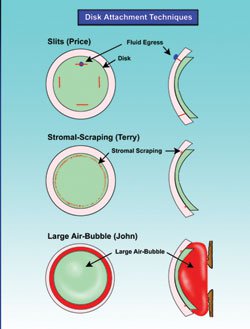 Figure 1. Schematic representation of three surgical techniques to increase donor corneal disc attachment to the recipient cornea. One or two preoperative laser inferior peripheral iridotomies or surgical intraoperative peripheral iridectomy is performed when the large air bubble technique is used. |
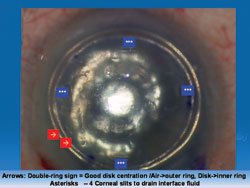 Figure 2. Intraoperative photograph showing four slits (asterisks), one in each quadrant to drain any interface fluid and increase adherence of the disc to the recipient corneal stroma. Also seen is the double-ring sign (arrows) of a well-centered donor corneal disc. The outer ring represents the border of the air bubble inside the anterior chamber and the inner ring represents the margin of the attached donor corneal disc. The donor-recipient interface is very smooth and uniform without any interface debris or donor corneal folds in DSAEK surgery. Figures 1, 2, 3, 5 and 8 reproduced
with permission from Jaypee Medical Publishers. |
Using the three-prong donor disc attachment technique can result in donor disc detachment rate of zero in DSAEK surgery, thus potentially eliminating additional surgical procedures such as the “re-bubble” procedure to attach a detached donor corneal disc.
Surgical techniques
Descemetorhexis and detachment of the Descemet’s membrane as a single disc can be performed using a single instrument, namely the John Dexatome spatula (ASICO) through a single entry wound into the anterior chamber (Figure 4).
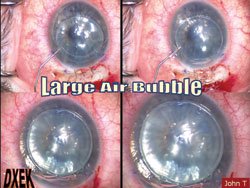 Figure 3. A large air bubble is used to attach the donor corneal disc to the inner stromal surface of the recipient cornea. The air is injected in a gradual and steady manner to prevent donor disc dislocation or inversion of the disc (“flipped disc”). |
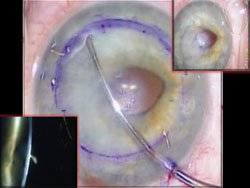 Figure 4. Descemetorhexis using the John Dexatome DSAEK spatula (ASICO); (inserts) Intraoperative broad and slit-lamp views displaying the corneal stromal edema. Image: John T |
After the exposure of the recipient inner corneal stroma, the peripheral corneal stroma is roughened using the John DSAEK scrubber (ASICO) (Figure 5). The curvilinear design of these instruments allows easy access to every area within the inner corneal dome. Mark A. Terry, MD, first described this technique of roughening the peripheral recipient exposed corneal stroma to increase the donor disc attachment.
We know from the deep lamellar endothelial keratoplasty experience that there is good adherence between the roughened host corneal stroma and the rough, manually dissected donor corneal disc. This concept of increased stromal adherence when the stromal surfaces are rough is carried over from deep lamellar endothelial keratoplasty surgery to DSAEK surgery, except the central region of the host cornea including the visual axis is not roughened. Only a narrow peripheral band of the recipient corneal stroma is roughened inside the circle of the host descemetorhexis (Figure 5).
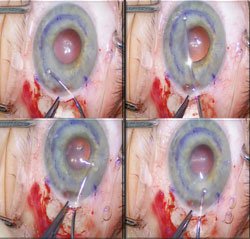 Figure 5. Band of peripheral roughening of the recipient corneal stroma within the circular epithelial mark. |
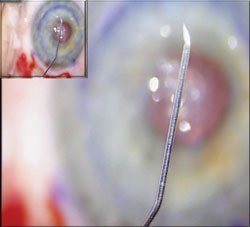 Figure 6. A reverse-bent 30-gauge sterile needle. Image: John T |
The second step in increasing donor disc adherence is the use of a reverse-bent 30-gauge sterile needle (Figure 6). Using this needle, four areas (nasal, superior, temporal and inferior, clockwise direction) of “stromal-velcro-patch” formation are created (Figure 7). This step creates stromal fiber release from the recipient cornea toward the anterior chamber in these four patches to further increase the focal attachments of the donor disc to the recipient cornea in these two primary meridians.
The third and final step in this three-prong approach is the use of a large air bubble in the anterior chamber (Figure 8). This is usually combined with a preoperative laser peripheral iridotomy procedure or an intraoperative surgical peripheral iridectomy in the inferior aspect of the iris, as recommended by Elizabeth Davis, MD.
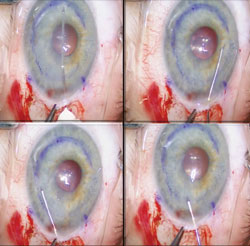 Figure 7. Four-patch (nasal, superior, temporal and inferior) “stromal-velcro-patch” formation using a reverse-bent needle, creating stromal fiber release toward the anterior chamber for increased adherence of the donor corneal disc to the inner surface of the recipient cornea. Image: John T |
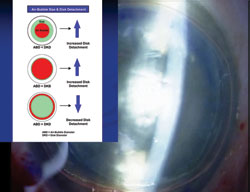 Figure 8. Broad slit-view of a large air bubble pushing the donor corneal disc against the host corneal stroma. The band of fine circular corneal roughening, combined with the four stromal-velcro-patch located in the nasal, superior, temporal and inferior areas further facilitate optimal disc adherence to the patient’s cornea and prevents disc detachment; (insert) Schematic representation of the relative size of the air bubble in the anterior chamber to the size of the donor corneal disc; (top) there is increased risk of donor corneal detachment when the air bubble diameter (ABD) is smaller than the donor corneal disc diameter (DKD); (middle) When ABD=DKD, there is still increased risk of disc detachment; (bottom) When ABD>DKD, there is decreased risk of disc detachment. |
This is performed in an attempt to prevent postoperative pupillary block glaucoma attack. The author is of the opinion that the diameter of the air bubble within the recipient anterior chamber should be greater than the diameter of the donor corneal disc to prevent disc detachment (Figures 1, 3 and 8). If the air bubble has a smaller diameter than the disc diameter, there is increased risk of disc detachment (Figure 8).
The author usually leaves a large air bubble in the anterior chamber at the end of the procedure. The globe is palpated intraoperatively to assure that the IOP is within the acceptable range, and the patient is asked whether he or she can perceive light during this surgical procedure. The potential downside to a large air bubble includes pupillary block glaucoma attack on the evening of surgery.
The peripheral iridotomies or iridectomy should help prevent possible pupillary block glaucoma. There is usually no such risk of a pupillary block glaucoma attack the next day because the air bubble consistently is at or above the horizontal meridian bisecting the central pupil through the visual axis.
This three-prong approach usually results in decreasing the donor disc detachment rate to zero, which is a welcome result for DSAEK surgery.
References:
- John T. Corneal disc detachment. Annals of Ophthalmol. 2006;38:169-184.
- John T. Corneal Endothelial Transplant (DSAEK, DMEK, & DLEK). New Delhi, India: Jaypee Brothers Medical Publishers; in press.
- John T. Descemetorhexis with endokeratoplasty (DXEK). In: John T, ed. Step by Step Anterior and Posterior Lamellar Keratoplasty. New Delhi, India: Jaypee Brothers Medical Publishers; 2006:177-196.
- John T. Descemetorhexis with endokeratoplasty. In: John T, ed. Lamellar Corneal Surgery. New York, NY: McGraw-Hill Companies; 2008:411-420.
- John T. Selective tissue corneal transplantation: a great step forward in global visual restoration. Expert Rev Ophthalmol. 2006;1:5-7.
- Thomas John, MD, is a clinical associate professor at Loyola University at Chicago and is in private practice in Tinley Park and Oak Lawn, Ill. He can be reached at 708-429-2223; fax: 708-429-2226; e-mail: tjcornea@gmail.com. Dr. John receives a small royalty from ASICO for surgical instruments.

